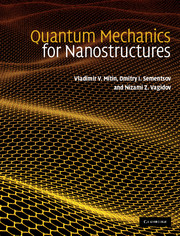Book contents
- Frontmatter
- Contents
- Preface
- List of notation
- 1 The nanoworld and quantum physics
- 2 Wave–particle duality and its manifestation in radiation and particle behavior
- 3 Layered nanostructures as the simplest systems to study electron behavior in a one-dimensional potential
- 4 Additional examples of quantized motion
- 5 Approximate methods of finding quantum states
- 6 Quantum states in atoms and molecules
- 7 Quantization in nanostructures
- 8 Nanostructures and their applications
- Appendix A Classical dynamics of particles and waves
- Appendix B Electromagnetic fields and waves
- Appendix C Crystals as atomic lattices
- Appendix D Tables of units
- Index
4 - Additional examples of quantized motion
Published online by Cambridge University Press: 05 June 2012
- Frontmatter
- Contents
- Preface
- List of notation
- 1 The nanoworld and quantum physics
- 2 Wave–particle duality and its manifestation in radiation and particle behavior
- 3 Layered nanostructures as the simplest systems to study electron behavior in a one-dimensional potential
- 4 Additional examples of quantized motion
- 5 Approximate methods of finding quantum states
- 6 Quantum states in atoms and molecules
- 7 Quantization in nanostructures
- 8 Nanostructures and their applications
- Appendix A Classical dynamics of particles and waves
- Appendix B Electromagnetic fields and waves
- Appendix C Crystals as atomic lattices
- Appendix D Tables of units
- Index
Summary
In the previous chapter we have analyzed the peculiarities of quantized electron motion in layered structures with one-dimensional potential wells. From the mathematical point of view, the solution of the Schrödinger equation for one-dimensional potential profiles is much simpler. However, many quantum objects, such as atoms, molecules, and quantum dots, are three-dimensional objects. Thus, in order to analyze electron motion in such objects we need to find solutions of the Schrödinger equation for three-dimensional potential profiles. The electron motion in spaces with dimensionality higher than one, especially for rectangular potential profiles with infinite potential barriers, is not so difficult to analyze. At the same time we have to keep in mind that such potential profiles frequently represent some approximation of the more complex, real potential profiles. Depending on the type of structure and on the form of the potential profile, the electron motion may be limited in two directions (two-dimensional quantization) or in three directions (three-dimensional quantization). In this chapter we will show that the existence of discrete energy levels in the electron spectrum is an intrinsic feature of electron motion in potential wells of any form and dimensionality.
An electron in a rectangular potential well (quantum box)
In the previous chapter we studied the electron motion in one-dimensional potential wells. An electron's motion along one direction was confined by the potential profile and the momentum in this direction was quantized.
- Type
- Chapter
- Information
- Quantum Mechanics for Nanostructures , pp. 105 - 135Publisher: Cambridge University PressPrint publication year: 2010



